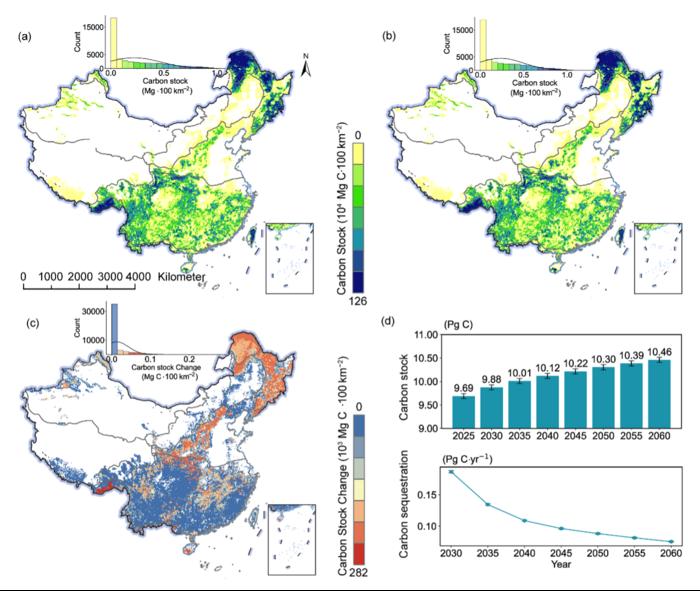
China’s natural forests have long been a cornerstone for carbon sequestration, substantially mitigating climate change through their ability to absorb atmospheric carbon dioxide. A recent study published in the journal Forest Ecosystems yields significant insights into the future dynamics of aboveground carbon stocks in these forests, positing that while these ecosystems will continue to capture carbon, their capacity to do so is diminishing over time. The findings underscore the urgency for targeted conservation strategies as China navigates the complexities of climate resilience.
This groundbreaking research employed a multi-faceted methodological approach, melding satellite imagery with field surveys to generate precise estimates of carbon sequestration potential. The researchers meticulously analyzed biomass and forest age data to construct predictive models that illustrate how China’s natural forests could perform under optimal growth conditions. Unlike traditional broad-scale assessments, this study reveals nuanced regional trajectories by mapping carbon storage with unprecedented detail at a resolution of 0.1°, thereby identifying specific regional variances in carbon sequestration capabilities.
An intriguing outcome of this comprehensive study highlights that the warm temperate deciduous broadleaf forest zones, which are predominantly populated with younger forests, are anticipated to exhibit the most significant increase in carbon storage—projected to surge by 26.36% by the year 2060. In sharp contrast, the mature forests of the Qinghai-Tibet Plateau Alpine region showcase a mere 0.74% rise in carbon storage. This stark disparity advocates for a deeper understanding of forest growth stages as it relates to carbon absorption potential.
The lead researcher, Professor Qinghua Guo, articulates the essence of this finding, stating, “We found that forests at different growth stages have very different carbon storage potential. Younger forests still have room to grow, while older ones are reaching their limit.” This anatomy of growth stages deepens our understanding of how various forest types contribute differently to climate goals and calls for differentiated management strategies to optimize their carbon storage potential.
China’s commitment to forest conservation and extensive reforestation initiatives has been widely acknowledged. However, findings from this research illuminate a broader truth: merely expanding forested areas may not suffice in the fight against climate change. With the rate of carbon sequestration diminishing, safeguarding old-growth forests becomes crucial. Collaboration between conservationists and policymakers will be essential to balance growth and protection initiatives effectively.
Significantly, external factors such as climate change, wildfires, and prolonged droughts pose exacerbating challenges to forest carbon storage. These elements could accelerate the timeline of ecological disruption and diminish the capacity of forests to sequester carbon. Therefore, establishing robust long-term monitoring processes is vital for understanding how ongoing environmental changes influence forest health and carbon dynamics.
Moreover, the implications of this research extend beyond local ecosystems. As nations grapple with their respective climate commitments, understanding the nuances of carbon storage within forested environments can inform global policy decisions. By gaining insights into where investments can yield the highest returns in carbon sequestration, countries can advance both their sustainability goals and international climate commitments.
China’s approach underscores the necessity for tailored strategies that accommodate the inherent diversity of forest ecosystems. Initiatives that prioritize the protection of older, mature forests while also nurturing younger ones may ultimately foster enhanced resilience in the face of climate challenges. Additionally, integrating advanced technologies into forest management practices could optimize monitoring and data collection, ensuring that conservation efforts yield tangible results.
As researchers continue to refine models for carbon sequestration, the focus on developing more accurate metrics will enable stakeholders to make informed decisions. The implications of these findings may pave the way for targeted policy frameworks that align environmental stewardship with economic interests, showcasing the value of sustainable forest management as an investment in both ecological health and economic vitality.
In conclusion, this study offers a clarion call for intensified conservation efforts that prioritize both the protection of existing forests and the cultivation of new growth. The intersection of rigorous scientific inquiry and policy development holds promise for mitigating the effects of climate change while advancing global sustainability goals. The complexities of forest dynamics will require ongoing research and innovative thinking as we strive to enhance carbon storage and combat climate change in an increasingly volatile world.
Subject of Research: Future aboveground carbon stocks in natural forests of China
Article Title: Spatio-temporal dynamics of future aboveground carbon stocks in natural forests of China
News Publication Date: 2-Jan-2025
Web References: DOI Link
References: National Key Research and Development Program of China; National Natural Science Foundation of China
Image Credits: Qinghua Guo et al.
Keywords: Carbon sequestration, natural forests, climate change, biomass, conservation strategies, sustainable forestry.
Tags: aboveground carbon stocks in forestsbiomass and forest age analysisChina forest carbon sequestrationclimate change mitigation strategiesclimate resilience in forestryconservation strategies for natural forestsforest ecosystem studiesfuture of carbon sinks in Chinapredictive models for carbon captureregional carbon storage dynamicssatellite imagery in forest researchwarm temperate deciduous broadleaf forests

